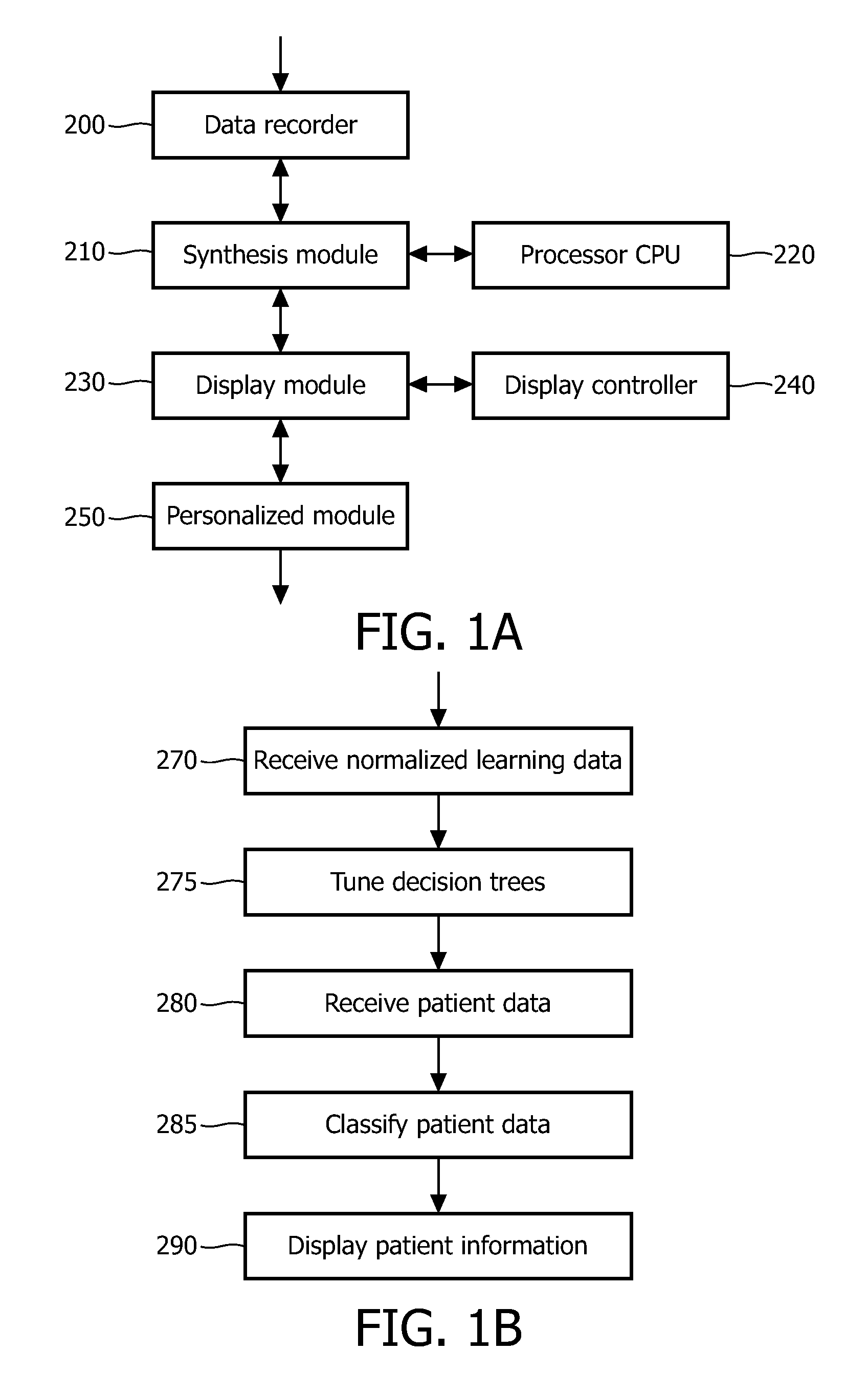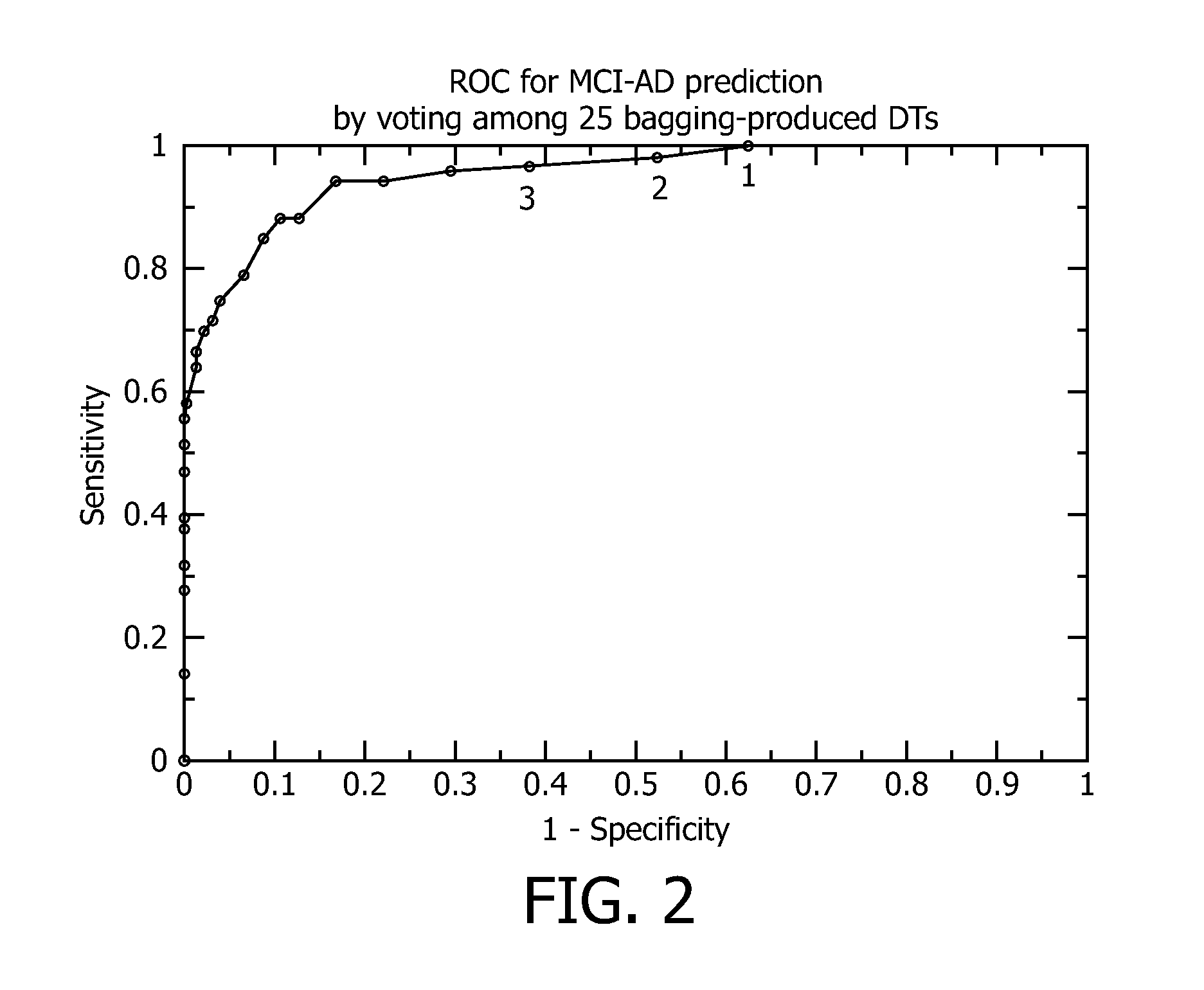Methods and systems for identifying patients with mild cognitive impairment at risk of converting to alzheimer's
a technology for mild cognitive impairment and patients applied in the field of methods and systems for identifying patients with mild cognitive impairment at risk of converting to alzheimer's, can solve the problems of inability to do so, reducing the ability of clinical trials to prove the efficacy of a treatment, and rejecting medications or treatments that are effective, etc., and achieving the effect of not being able to demonstrate the effectiveness through statistical means
- Summary
- Abstract
- Description
- Claims
- Application Information
AI Technical Summary
Benefits of technology
Problems solved by technology
Method used
Image
Examples
example 1
[0151]A Set of NPTs is Shown in Table 1.
[0152]
TABLE 1NPTs required for input#Test Item NameLabel1Wechsler Logical Memory totalLIMMTOTAL2Wechsler Logical Memory delay totalLDELTOTAL3Wechsler Logical Memory delay queuedLDELCUE4Digit Span Forward scoreDSPANFOR5Digit Span Forward lengthDSPANFLTH6Digit Span Backward scoreDSPANBAC7Digit Span Backward lengthDSPANBLTH8Rey's Auditory Verbal Learning total trial 6AVTOT69Rey's Auditory Verbal Learning errors trial 6AVERR610Rey's Auditory Verbal Learning 30 minuteAVDEL30MINdelay total11Rey's Auditory Verbal Learning 30 minuteAVDELERR1delay errors12Rey's Auditory Verbal Learning 30 minuteAVDELTOTdelay recognized on list13Rey's Auditory Verbal Learning 30 minuteAVDELERR2delay errors on list14Boston Naming TestBNTTOTAL15Categories Animals ScoreCATANIMSC16Categories Animals PerseverationsCATANPERS17Categories Animals IntrusionsCATANINTR18Categories Vegetables ScoreCATVEGESC19Categories Vegetables PerseverationsCATVGPERS20Categories Vegetables intru...
example 2
[0154]Raw scores are first corrected for the influences of gender, race, age, and years of education when these factors were found to be significant in the cohort of stable normal controls in the ADNI study. The resulting corrections are summarized in Table 2.
[0155]
TABLE 2Summary of z-score correctionsLabelCorrection modelLIMMTOTALgender, eduLDELTOTALgender, race, eduLDELCUEnoneDSPANFORage, eduDSPANFLTHeduDSPANBACeduDSPANBLTHeduAVTOT6noneAVERR6noneAVDEL30MINnoneAVDELERR1noneAVDELTOTgender, rage, eduAVDELERR2gender, eduBNTTOTALgender, eduCATANIMSCeduCATANPERSnoneCATANINTRgender, raceCATVEGESCgenderCATVGPERSnoneCATVGINTRgender, ageTRAASCORgender, race, age, eduTRAAERRCOMgender, race, age, eduTRAAERROMnoneTRABSCORage, eduTRABERRCOMgender, race, ageTRABERROMnoneDIGITSCORgender, age, eduMMSCOREgender, race, age, eduADAS_COG_Q1_WORD_RECALLgenderADAS_COG_Q2_COMMANDSnoneADAS_COG_Q3_CONSTRUCTIONeduADAS_COG_Q4_DEL_WORD_RECALgenderASAD_COG_Q5_NAMINGgender, race, eduADAS_COG_Q6_IDEA_PRAXISnoneA...
example 3
[0158]In an exemplary embodiment, a set of decision trees is shown below, which use the input data z-scores described above. Using these corrected Z-scores, each of the twenty-five (25) decision trees returns an output value of zero (0), which represents no conversion from MCI to AD, or an output value of one (1), which represents conversion from MCI to AD. The patient threshold value, n, is the sum of the output values for the twenty-five (25) decision trees.
PUM
 Login to View More
Login to View More Abstract
Description
Claims
Application Information
 Login to View More
Login to View More - R&D
- Intellectual Property
- Life Sciences
- Materials
- Tech Scout
- Unparalleled Data Quality
- Higher Quality Content
- 60% Fewer Hallucinations
Browse by: Latest US Patents, China's latest patents, Technical Efficacy Thesaurus, Application Domain, Technology Topic, Popular Technical Reports.
© 2025 PatSnap. All rights reserved.Legal|Privacy policy|Modern Slavery Act Transparency Statement|Sitemap|About US| Contact US: help@patsnap.com



